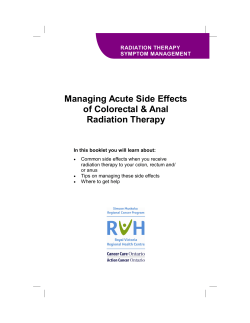
M PREVENT EYE DAMAGE Protect Yourself from UV Radiation
PREVENT EYE DAMAGE Protect Yourself from UV Radiation M ost Americans understand the link between ultraviolet (UV) radiation and skin cancer. Many are less aware of the connection between UV radiation and eye damage. With increased levels of UV radiation reaching the Earth’s surface, largely due to stratospheric ozone layer depletion, it is important to take the necessary precautions to protect your eyes. Potential Effects of UV Radiation on Eyes UV radiation, whether from natural sunlight or artificial UV rays, can damage the eye, affecting surface tissues and internal structures, such as the cornea and lens. Long-term exposure to UV radiation can lead to cataracts, skin cancer around the eyelids, and other eye disorders. In the short term, excessive exposure to UV radiation from daily activities, including reflections off of snow, pavement, and other surfaces, can burn the front surface of the eye, similar to a sunburn on the skin. The cumulative effects of spending long hours in the sun without adequate eye protection can increase the likelihood of developing the following eye disorders: ®Cataract: A clouding of the eye’s lens that can blur vision. ®Snow Blindness (Photokeratitis): A temporary but painful burn to the cornea caused by a day at the beach without sunglasses; reflections off of snow, water, or concrete; or exposure to artificial light sources such as tanning beds. ®Pterygium: An abnormal, but usually non-cancerous, growth in the corner of the eye. It can grow over the cornea, partially blocking vision, and may require surgery to be removed. ®Skin Cancer around the Eyelids: Basal cell carcinoma is the most common type of skin cancer to affect the eyelids. In most cases, lesions occur on the lower lid, but they can occur anywhere on the eyelids, in the corners of the eye, under the eyebrows, and on adjacent areas of the face. Did You Know…. ®22.3 million Americans have cataracts. ®The direct medical costs of cataracts are $6.8 billion annually. Source: National Eye Institute, National Institutes of Health, U.S. Department of Health and Human Services, www.nei.nih.gov and Prevent Blindness America, www.preventblindness.org Recycled/Recyclable—Printed with vegetable oil-based inks on processed chlorine-free paper that contains at least 50% post-consumer fiber. EPA’s SunWise Program: Educating Youth About Sun Safety The SunWise Program is an environmental and health education program that teaches children and their caregivers how to protect themselves from overexposure to the sun. The program uses classroom, school, and community components to develop sustained sun-safe behaviors in children. When choosing sunglasses for children, SunWise, in partnership with Prevent Blindness America, recommends that you: ®Read the labels: Always look for labels that clearly state the sunglasses block 99–100 percent of UV-A and UV-B rays. ®Check often to make sure the sunglasses fit well and are not damaged. ®Choose sunglasses that fit your child’s face and lifestyle but that are large enough to shield the eyes from most angles. ®Find a wide-brimmed hat to wear with the sunglasses. Wide-brimmed hats greatly reduce the amount of UV radiation that reaches the eyes. For more information about SunWise and how you can participate, please visit www.epa.gov/sunwise. Protect Your Eyes The greatest amount of UV protection is achieved with a combination of: sunglasses that block 99–100 percent of both UV-A and UV-B rays; a wide-brimmed hat; and for those who wear contact lenses, UV-blocking contacts. Wrap-around sunglasses and wide-brimmed hats add extra protection because they help block UV rays from entering the eyes from the sides and above. Frequently Asked Questions Q: Who is at risk for eye damage? A: Everyone is at risk. Every person in every ethnic group is susceptible to eye damage from UV radiation. Q: When do I need to wear sunglasses? A: Every day, even on cloudy days. Snow, water, sand, and pavement reflect UV rays, increasing the amount reaching your eyes and skin. Q: What should I look for when choosing a pair of sunglasses? A: No matter what sunglass styles or options you choose, you should insist that your sunglasses block 99–100 percent of both UV-A and UV-B radiation. Q: Do I have to buy expensive sunglasses to ensure that I am being protected from UV radiation? A: No. As long as the label says that the glasses provide 99–100 percent UV-A and UV-B protection, price should not be a deciding factor. Q: Do all contact lenses block UV rays? A: No. Not all contact lenses offer UV protection and not all provide similar absorption levels. Ask your eye care professional for more information, and remember, a combination approach works best! For more information, contact: American Academy of Ophthalmology, www.aao.org American Optometric Association, www.aoa.org National Eye Institute, www.nei.nih.gov Prevent Blindness America, www.preventblindness.org REMEMBER— Exposure to UV radiation has cumulative effects on the eyes. Damage today leads to eye problems tomorrow. Office of Air and Radiation (6205J) EPA 430-F-13-023 May 2013 www.epa.gov/sunwise PROTECT YOUR EYES EVERY DAY— WEAR UV-BLOCKING LENSES AND A HAT.
© Copyright 2025





















